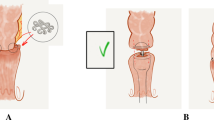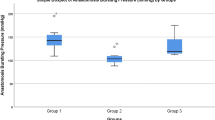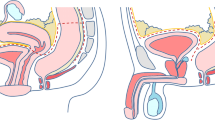Abstract
Background
Paclitaxel has been used frequently for Hyperthermic Intraperitoneal Chemotherapy (HIPEC) for ovarian carcinomatosis. Cytoreductive surgery and HIPEC are associated with high rates of morbidity being anastomotic dehiscence one of the most frequent. The objective of this study is to quantify the effect of Paclitaxel-based HIPEC on colonic anastomosis in an experimental rat model.
Methods
After left colon resection and anastomosis, animals were randomized into four groups: Controls (C); Hyperthermia (H); Normothermic Intraperitoneal Paclitaxel (CP) and Paclitaxel-based HIPEC (HP). On postoperative day four, animals’ peritoneal cavities were examined macroscopically, colon anastomosis burst pressures measured and specimens analyzed histologically.
Results
Thirty-nine animals were randomized and 36 were included in the analysis. H group presented the highest burst pressure 105.11 ± 22.9 mmHg, which was 27% higher than C (77.89 ± 27.6 mmHg). On the other hand, HP presented the lowest burst pressure 64 ± 26 mmHg, 16% lower than C group and 39% lower than H, being this latter difference statistically significant (p = 0.004). There were no significant differences regarding weight loss, adhesion scores, perianastomotic abscesses and histological findings (inflammation, fibroblasts, neoangiogenesis, and collagen among groups).
Conclusion
Strength of colonic anastomosis was improved by isolated hyperthermia and negatively affected by Paclitaxel-based HIPEC.



Similar content being viewed by others
References
Sugarbaker PH. Peritonectomy procedures. Ann Surg. 1995;221:29–42.
Smeenk RM, Verwaal VJ, Zoetmulder FA. Toxicity and mortality of cytoreduction and intraoperative hyperthermic intraperitoneal chemotherapy in pseudomyxoma peritonei—a report of 103 procedures. Eur J Surg Oncol. 2006;32:186–90.
Nesbakken A, Nygaard K, Lunde OC, et al. Anastomotic leak following mesorectal excision for rectal cancer: true incidence and diagnostic challenges. Colorectal Dis. 2005;7:576–81.
Frasson M, Flor-Lorente B, Rodríguez JL, et al. Risk factors for anastomotic leak after colon resection for cancer: multivariate analysis and nomogram from a multicentric, prospective, national study with 3193 patients. Ann Surg. 2015;262:321–30.
Pelz JO, Doerfer J, Decker M, et al. Hyperthermic intraperitoneal chemoperfusion (HIPEC) decrease wound strength of colonic anastomosis in a rat model. Int J Colorectal Dis. 2007;22:941–7.
Khoury GA, Waxman BP. Large bowel anastomosis. I. The healing process and sutured anastomosis. A review. Br J Surg. 1983;70:61–3.
Fumagalli U, Trabucchi E, Soligo M, et al. Effects of intraperitoneal chemotherapy on anastomotic healing in rats. J Surg Res. 1991;50:82–7.
Makrin V, Lev-Chelouche D, Even Sapir E, et al. Intraperitoneal heated chemotherapy affects healing of experimental colonic anastomosis: an animal study. J Surg Oncol. 2005;89:18–22.
Wagner OJ, Inglin RA, Bisch-knaden S, et al. Sirolimus and intraoperative hyperthermic peritoneal chemoperfusion with mitomycin-C do not impair healing of bowel anastomoses. Transpl Int. 2008;21:554–63.
Arikan AY, Günal O, Pehlivan M, et al. The effect of intraperitoneal paclitaxel administration on colonic anastomosis. Hepatogastroenterology. 2000;47:1273–6.
Uzunkoy A, Bolukbas C, Horoz M, et al. The optimal starting time of postoperative intraperitoneal mitomycin-C therapy with preserved intestinal wound healing. BMC Cancer. 2005;5:31.
Kanellos I, Mantzoros I, Demetriades H, et al. Healing of colon anastomoses covered with fibrin glue after immediate postoperative intraperitoneal administration of 5-fluorouracil. Dis Colon Rectum. 2004;47:510–5.
Kuzu M, Koksoy C, Kale T, et al. Experimental study of the effect of preoperative 5-fluorouracil on the integrity of colonic anastomoses. Br J Surg. 1985;85:236–9.
Kanellos D, Pramateftakis MG, Demetriades H, et al. Healing of colonic anastomoses after immediate postoperative intraperitoneal administration of oxaliplatin. Int J Colorectal Dis. 2008;23:1185–91.
Morrison JP, Coleman MC, Aunan ES, et al. Aging reduces responsiveness to BSO- and heat stress-induced perturbations of glutathione and antioxidant enzymes. Am J Physiol Regul Integr Comp Physiol. 2005;289:R1035–41.
Cui Y, Liu B, Xie J, et al. Effect of heat stress and recovery on viability, oxidative damage, and heat shock protein expression in hepatic cells of grass carp (Ctenopharyngodon idellus). Fish Physiol Biochem. 2013;40:721–9.
Oliver SR, Philips NA, Novosad VL, et al. Hyperthermia induces injury to the intestinal mucosa in the mouse: evidence for an oxidative stress mechanism. Am J Physiol Regul Integr Comp Physiol. 2012;302:R845–53.
Pelz JO, Vetteriein M, Grimming T, et al. Hyperthermic intraperitoneal chemotherapy in patients with peritoneal carcinomatosis: role of heat shock proteins and dissecting effects of hyperthermia. Ann Surg Oncol. 2013;20:1105–13.
Altup S, Demiryürek AT, Ak D, et al. Contribution of peroxynitrite to the beneficial effects of preconditioning on ischaemia-induced arrhythmias in rat isolated hearts. Eur J Pharmacol. 2001;415:239–46.
Csonka C, Csont Onody A, et al. Preconditioning decreases ischemia/reperfusion-induced peroxynitrite formation. Biochem Biophys Res Commun. 2001;285:1217–9.
Cascales Campos P, Gil J, Parrilla P. Morbidity and mortality outcomes of cytoreductive surgery and hyperthermic intraperitoneal chemotherapy in patients with primary and recurrent advanced ovarian cancer. Eur J Surg Oncol. 2014;40:970–5.
BOE.es [Internet]. Spain: agencia estatal boletín oficial del estado. Available at: http://boe.es/buscar/doc.php?id=BOE-A-2005-17344. Accessed 25 Oct 2005.
Farriol M, Rosselló J, Schwartz S. Body Surface area in Sprague-Dawley rats. J Anim Physiol Anim Nutr (Berl). 1997;77:61–5.
Charan J, Kantharia ND. How to calculate sample size in animal studies? J Pharmacol Pharmacother. 2013;4:303–6.
Aarts F, Blechrodt RP, de Man B, et al. The effects of adjuvant experimental radioimmunotherapy and hyperthermic intraperitoneal chemotherapy on intestinal and abdominal healing after cytoreductive surgery for peritoneal carcinomatosis in the rat. Ann Surg Oncol. 2008;15:3299–307.
Marjanovic G, Jüttner E, zur Hausen A, et al. Ischemic preconditioning improves stability of intestinal anastomoses in rats. Int J Colorectal Dis. 2009;24:975–81.
Zacharakis E, Demetriades H, Kanellos D, et al. Contribution of insulin-like growth factor I to the healing of colonic anastomoses in rats. J Invest Surg. 2007;20:9–14.
Makrin V, Lev-Chelouche D, Even Sapir E, et al. Intraperitoneal heated chemotherapy affects healing of experimental colonic anastomosis: an animal study. J Surg Oncol. 2005;89:18–22.
Yüceyar S, Ertürk S, Temiz M, et al. Role of the antiangiogenetic drug paclitaxel on healing of intestinal anastomosis: an experimental study. Tech Coloproctol. 2005;9:201–5.
Shimizu T, Maeta M, Koga S. Influence of local hyperthermia on the healing of small intestinal anastomoses in the rat. Br J Surg. 1991;78:57–9.
Author information
Authors and Affiliations
Corresponding author
Ethics declarations
Conflicts of interest
The authors declared no conflict of interest. No third-party financial funds or materials were accepted or necessary for the execution of this research project.
Research involving human participants and/or animals
Maintenance and care of all the animals included were according with national directives from the Protection commission and National Institute of health for laboratory animal.
Informed consent
The research did not involve human participants.
Rights and permissions
About this article
Cite this article
López-López, V., Lynn, P.B., Gil, J. et al. Effect of Paclitaxel-based Hyperthermic Intraperitoneal Chemotherapy (HIPEC) on colonic anastomosis in a rat model. Clin Transl Oncol 21, 505–511 (2019). https://doi.org/10.1007/s12094-018-1948-7
Received:
Accepted:
Published:
Issue Date:
DOI: https://doi.org/10.1007/s12094-018-1948-7




